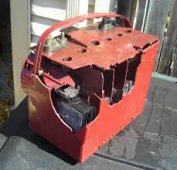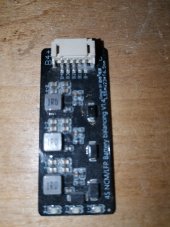Frank in Thailand
making mistakes so you don't have to...
Yes, I missed that small part.
"Will start to breakdown the organic electrolyte..."
Is a sentence that doesn't tell much. Actually nothing.
Not that it is dangerous to continue to use a cell if it has been charged over 4.2v.
When you drive your car one KM, almost all parts started to breakdown. That doesn't mean it's no longer safe.
The smell of electrolyte is absolutely not organic.
Some I could find:
The most commonly used electrolyte is comprised of lithium salt, in an "organic solution"
Deeper search shows something like"
electrode materials grafted aminophenyl, bromophenyl , and benzene-trifluoromethanesulfonylimide"
Organic is a strange word.
Gasoline is organic, so is Chlorine, Botox and Melons. Original from organic source..
Melons are in my dictionary organic, gasoline isn't.
Yours might be different.
You are missing the point.
There is absolutely not reason to believe that overcharge to +4.2 will increase the chances of an internal short.
Even if it would occur..
it will get warm.
lithium polymer will get so warm(hot) it will explode.
LiFePO4 just gets warm.
Unless there is flammable material that will combust at that temperature, there is absolutely no danger at all.
No more then lead acid battery, (who can explode....)

If the statement is that all battery should be in a safe environment that can handle accidents, yes. I fully agree.
You should not place any battery without protection under your bed and charge it.
If it's about increase risk, to a level that it's no longer safe to use...
Clear, I absolutely disagree.
That there is some damage, more lithium plating, less capacity and lesser cycle life, I think we both can agree.
In the last year, I have had this discussion several times.
People who have been exposed so many times to the warning of puffy lithium battery, that their eyes colour red when the read the both words. Not realize that LiFePO4 is not lithium polymer.
The ones who don't own LiFePO4, or have healty ones shout "danger!!!" And "replace"
A few months down the road when they have some pillows them selves, suddenly the danger isn't enough to replace.
As it will cost them money.
Most ideal, not for the environment but to have the most stable setup?
Sure, replace.
Talking about ideal:
You should only use laser welded compressed casing and laser welded busbars.
As that is how they are designed to be used.
All else is modification and increased danger of failure.
It's good to realize that the energy contained in a battery is dangerous, always.
In case of accident, there is a "bomb" waiting to go off.
(Figurative speaking)
"Will start to breakdown the organic electrolyte..."
Is a sentence that doesn't tell much. Actually nothing.
Not that it is dangerous to continue to use a cell if it has been charged over 4.2v.
When you drive your car one KM, almost all parts started to breakdown. That doesn't mean it's no longer safe.
The smell of electrolyte is absolutely not organic.
Some I could find:
The most commonly used electrolyte is comprised of lithium salt, in an "organic solution"
Deeper search shows something like"
electrode materials grafted aminophenyl, bromophenyl , and benzene-trifluoromethanesulfonylimide"
Organic is a strange word.
Gasoline is organic, so is Chlorine, Botox and Melons. Original from organic source..
Melons are in my dictionary organic, gasoline isn't.
Yours might be different.
You are missing the point.
There is absolutely not reason to believe that overcharge to +4.2 will increase the chances of an internal short.
Even if it would occur..
it will get warm.
lithium polymer will get so warm(hot) it will explode.
LiFePO4 just gets warm.
Unless there is flammable material that will combust at that temperature, there is absolutely no danger at all.
No more then lead acid battery, (who can explode....)

If the statement is that all battery should be in a safe environment that can handle accidents, yes. I fully agree.
You should not place any battery without protection under your bed and charge it.
If it's about increase risk, to a level that it's no longer safe to use...
Clear, I absolutely disagree.
That there is some damage, more lithium plating, less capacity and lesser cycle life, I think we both can agree.
In the last year, I have had this discussion several times.
People who have been exposed so many times to the warning of puffy lithium battery, that their eyes colour red when the read the both words. Not realize that LiFePO4 is not lithium polymer.
The ones who don't own LiFePO4, or have healty ones shout "danger!!!" And "replace"
A few months down the road when they have some pillows them selves, suddenly the danger isn't enough to replace.
As it will cost them money.
Most ideal, not for the environment but to have the most stable setup?
Sure, replace.
Talking about ideal:
You should only use laser welded compressed casing and laser welded busbars.
As that is how they are designed to be used.
All else is modification and increased danger of failure.
It's good to realize that the energy contained in a battery is dangerous, always.
In case of accident, there is a "bomb" waiting to go off.
(Figurative speaking)



